Transient Voltage Suppression in Automotive
By Isaac Sibson, Automotive Applications Engineer, Diodes Incorporated
In automotive applications, it’s essential to protect sensitive semiconductor components against power surges, transients and electrostatic discharge (ESD). A single transient voltage spike could easily damage or disrupt a component, while electrical noise of even relatively low energy can cause significant interruption to digital communications.
Transients can occur as momentary or continuous surges wherever high voltages are present, and can propagate through PCB tracks and cables. Momentary surges can easily reach 3kV and can often occur when inductive loads are switched, for example stopping a motor. As most modern integrated circuits (ICs) operate from low DC voltages, transients are a common threat to integrated circuits and digital signals.
To stop these transients, a common solution is the transient voltage suppressor (TVS). This article will explain the characteristics of TVS devices, and discuss how they may be used in automotive applications.
TVS explained
The TVS is a solid-state device, which provides a low-impedance path to earth for a transient voltage surge, but a high-impedance path at all other times. This allows supply voltages and signals to operate as intended, with no current routed via the TVS, but almost instantly clamps any high voltages safely, protecting sensitive components and routing the excess surge to earth.
A TVS is effectively a PN junction diode designed to enter avalanche mode, which means it can pass very high currents, when the potential on its cathode exceeds a predetermined level. This level will depend on the application, but the important characteristic is that the junction breaks down as quickly as possible (in less than one nanosecond), so that the transient surge is handled rapidly enough to avoid damage. The TVS would normally be placed either in parallel with the load across the 0V and supply rail, between ground and a single-ended signal, or across a differential pair of signals.
A TVS resembles a Zener diode, but is designed to operate slightly differently. Instead of handling a steady voltage for an appreciable length of time, a TVS is designed to break down quickly and absorb a higher amount of energy for a shorter time, which matches the profile of a surge or transient voltage.
TVS for Automotive
In most cars, the main voltage rail system is 12V DC, which is powered by the rectified and regulated output of an alternator, as well as from the battery. The alternator is inductive, and therefore a potential source of transient voltages.
As cars include more automated features, they include more electrical motors, for powering features such as mirrors, windows and seats. Also, the electrification of the drivetrain results in mechanical systems such as water and oil pumps being driven by electric motors. These all represent an inductive load on the system, and therefore are potential sources of transient voltages as loads are connected and disconnected.
There are specific standards to address surge protection for the automotive environment, including ISO 7637-2 and ISO 16750, while different countries have their own local standards. Figure 1 shows the shape of the test pulses on the 12V power rail defined by these two standards.
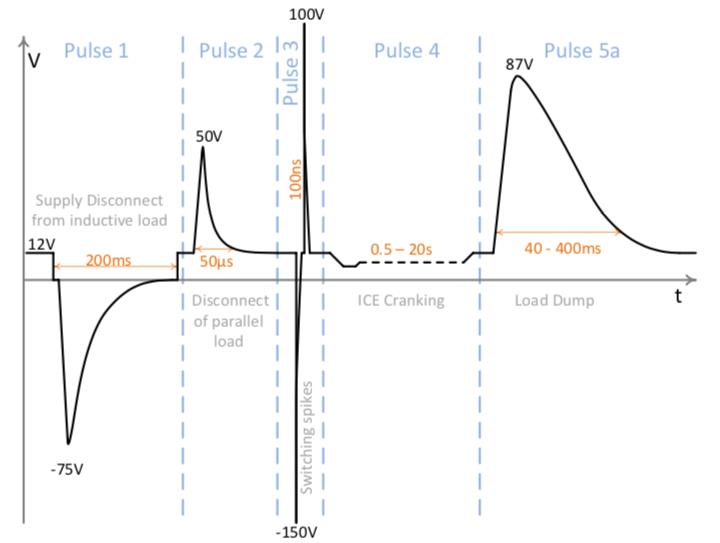
Figure 1: A representation of the test pulses used in the automotive industry
The circuit protection must be able to handle each of the pulses shown in Figure 1 (the pulses are not shown to scale). Designing to meet these requirements may involve using several TVS devices distributed around the entire system. For example, there will likely be a main load-dump TVS located close to the alternator, which would be physically large and chosen based on the characteristics of the system (Figure 2). The remaining energy would need to be dissipated by supplementary TVS protection within each module, and a system-level approach should be used to define the requirements for this.
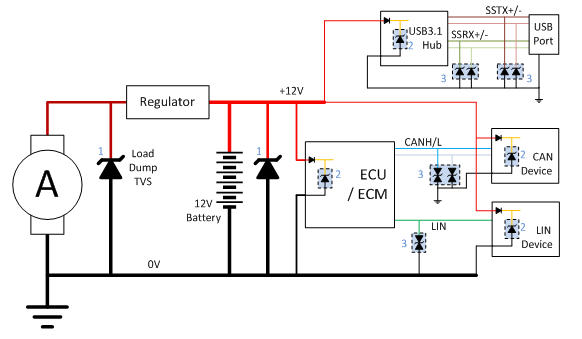
Figure 2: A depiction of where TVS devices are used in an automotive application. Large devices (1) around alternator and regulator; TVS and reverse polarity protection around electronic modules (2); and protection around data buses (3).
In harsh environments there will be a significantly larger area under the curve of the pulse, corresponding to more energy to be dissipated, compared to other use cases.
This holds true for automotive applications, where there may be significant energy to be handled. In particular, larger vehicles, such as trucks and vans, may have 24V supply rails, which means that the protection must be able to deal with much larger amounts of energy.
Protecting safety-critical signals with TVS devices
As modern vehicles include more and more data communications, the use of automotive-qualified TVS devices for networking standards such as CAN, FlexRay and LIN is increasing. These networks are used to carry safety-critical communications between automotive modules.
These signals may be interrupted by noise at a lower energy than transient surges. The signals and modules must therefore be protected, without impacting the signal bandwidth. As CAN and FlexRay are differential buses, they require a dual bidirectional TVS to protect both lines
The simplest type of TVS is unidirectional, and is used where the area of the circuit to be protected is always positive, for example 0 to 5V. The unidirectional TVS is still able to protect against both positive and negative transients.
In contrast, a bidirectional TVS is designed to provide protection from transients across a split-rail system or differential signaling scheme, to protect from transients that are both positive and negative with respect to the signal. These devices can be either symmetrical, which has the same breakdown voltage level in both directions, or asymmetrical, which has a reverse breakdown voltage that is higher in one direction.
The LIN bus would employ an asymmetrical bidirectional TVS, for example, because the signal line can easily fluctuate between -15V and +24V due to ground variance. A vehicle may also include high-speed data buses like USB and HDMI, which require low capacitance TVS protection to preserve data integrity.
TVS electrical characteristics
A TVS is specified based on the nominal working voltage. For example, that to protect a microcontroller operating at 3.3V, a TVS of 3.3V could be used.
The actual parameter being specified in this case is the reverse working voltage (VRWM), defined as the voltage at which the device is guaranteed not to pass more than a minimal specified leakage current IR (for example, less than 10µA). This means that VRWM is the voltage at which the TVS has a negligible influence on the rest of the circuit.
The related breakdown voltage parameter (VBR) is the point where the device will conduct at least a specified minimum current IT (for example, 10mA), and as can be seen in Figure 3, this is measured at the value of IT where the TVS starts to conduct strongly.
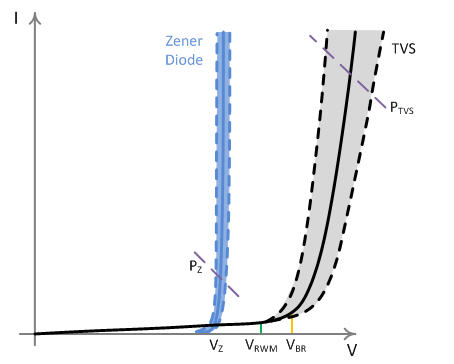
Figure 3: A TVS is designed to operate differently to a Zener diode, and for a shorter period
As shown by the dotted lines in Figure 3, VBR can vary over a wide tolerance, so it is important to consider this variation with respect to the circuit being protected. The device’s Peak Pulse Power limit, or PPK, can be found on the transfer characteristic of a TVS, as shown in Figure 4. The point at which the transfer curve intersects PPK denotes the maximum clamping voltage (VC) and maximum peak current (IPP) for the device.
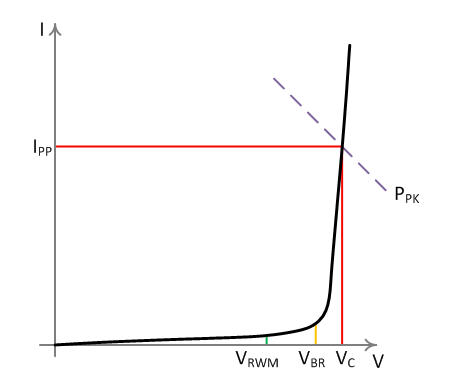
Figure 4: The transfer characteristics of a typical TVS
The length of the pulse determines the amount of energy that can be absorbed. Standard duration and magnitude pulses are defined in international standards. These include IEC 61000, which covers fast surges such as those caused by ESD discharges and lightning strikes, and defines two relevant points on the power curve: 8µs (t1) and 20µs (t2) – these are commonly referred to as 8/20.
Another relevant standard is IEC 6164, which deals with slower surges with higher energy levels, such as those that would occur from inductive loads. The time intervals for this standard are 10/1000, which equals 10µs (t1) and 1000µs (t2). These figures are used to define TVS performance, as shown in Figure 5. Note that t2 is total elapsed time from 0.
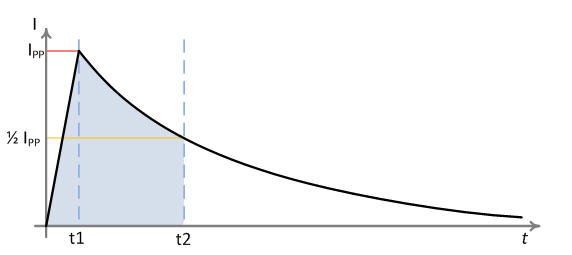
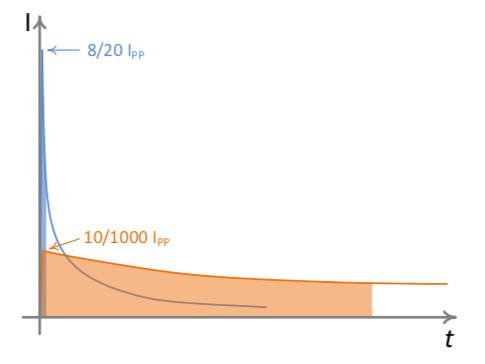
Figure 5: The top image shows how the points t1 and t2 are used to define the energy in the spike, while the bottom image shows the shape of the surges defined by the IEC standards. The shaded areas represent the energy of the pulses.
Conclusion
Transient voltages are an ever-present threat to sensitive integrated circuits, and in automotive applications they are unavoidable. The TVS is the right component, in many cases, to provide protection against surges, spikes and transients.
The choice of a TVS solution is highly system-dependent, as designs vary considerably, even for the same end product. Diodes Incorporated offers a wide range of TVS protection, and works closely with designers to fully understand their system requirements and recommend customized TVS solutions. This means that every part of the vehicle’s electronic systems can be protected from hazardous transients, delivering greater reliability and safety.